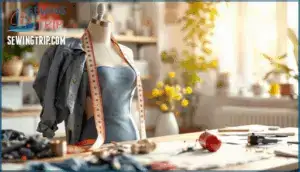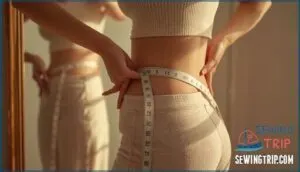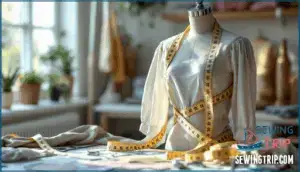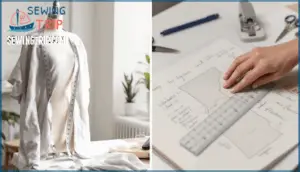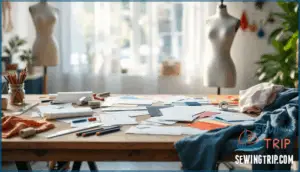This site is supported by our readers. We may earn a commission, at no cost to you, if you purchase through links.
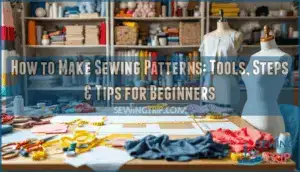
The process combines simple measurements, basic tools, and straightforward techniques that anyone can master. Whether you’re drafting from scratch or modifying existing patterns, understanding the fundamentals gives you the freedom to build a wardrobe that’s truly yours.
Let’s walk through the essential tools, measurements, and methods that turn your vision into wearable reality.
Table Of Contents
Key Takeaways
- Accurate measurements and proper tools are foundational—even quarter-inch errors can throw off an entire pattern, so investing in quality measuring tapes, rulers, pattern paper, and drafting supplies directly impacts your success.
- Flat patternmaking and draping are complementary techniques: flat patternmaking gives you predictable, graded results for production, while draping lets you sculpt fabric directly for complex designs, and choosing between them depends on your fit priorities and production goals.
- Testing your pattern on muslin before cutting final fabric catches fit issues early and prevents costly mistakes—this iterative process of making adjustments based on how the mockup actually drapes on your body is where patterns truly come to life.
- Digital patternmaking software operates 3-10 times faster than manual methods and streamlines the entire workflow from design through grading, making it essential for both beginners and professionals who want efficiency without sacrificing precision or the ability to customize garments.
Essential Tools for Making Sewing Patterns
Before you start drafting your first pattern, you’ll need to gather a few essential tools that make the process accurate and efficient. The right equipment transforms what could be a frustrating guessing game into a precise, repeatable method.
Here’s what you should have on hand to draft patterns with confidence.
Measuring Tapes, Rulers, and Curves
A good measuring tape is like a trusted sidekick—you’ll reach for it constantly, so invest in one that won’t stretch, twist, or betray you mid-measurement.
Clear rulers help you draft straight lines and precise seam allowances, while French curves smooth out armholes and necklines with ease.
Flexible curves let you capture body measurements and translate them into graceful pattern shapes that actually fit.
Pattern Paper and Manila Paper Rolls
Once you’ve got your tools ready, you’ll need something to draft on—and that’s where pattern paper and manila paper rolls come in. Manila pattern paper offers archival quality and a decent paper weight that won’t tear when you’re working through dart manipulation or grain direction placement.
Roll sizes vary from narrow to full-width, giving you flexibility for different patternmaking projects. You can also use lighter-weight paper for tracing, though heavier stock makes sturdier pattern drafting tools that last through repeated use.
Drafting Pencils, Erasers, and Markers
With your paper in place, you’ll want to mark it clearly—and the right drafting pencils, erasers, and markers make all the difference between patterns that work and ones that confuse you later. Here’s what you need:
- Mechanical pencils with 0.5mm or 0.7mm lead – Pencil lead grades like HB or 2H give you crisp lines that won’t smudge when you’re working with your French curve.
- White vinyl erasers – These eraser types lift graphite cleanly without damaging your pattern paper.
- Fine-tip permanent markers – Marker precision with archival inks makes certain your final pattern lines stay readable through years of use.
- Colored pencils for marking adjustments – Red or blue work great for noting alterations on pattern drafting tools.
- Pencils with ergonomic grips – Comfort matters when you’re spending hours on pattern drafting, especially during detailed pattern tracing wheel work.
Pattern Weights, Scissors, and Tracing Wheels
After you’ve marked your lines, you’ll need the right tools to keep your paper steady, cut with accuracy, and transfer your patterns to fabric. Pattern weights keep paper flat without pins—metal discs or fabric bags work well for patternmaking supplies.
Sharp shears cut clean edges; different scissor types serve specific sewing techniques. Tracing wheels transfer markings precisely when drafting patterns.
Tool maintenance, like sharpening blades regularly, guarantees cutting accuracy for beginners learning pattern drafting tools.
Taking and Using Accurate Body Measurements
Getting your measurements right is the foundation of a well-fitting pattern. You’ll need to measure several key points on your body, and it’s easier than you might think once you know where to start.
Let’s walk through the essential measurements you’ll be taking and how to use them effectively.
Measuring Bust, Waist, and Hips
Your three foundational measurements—bust, waist, and hips—are the backbone of every well-fitting pattern, so getting them right from the start saves you hours of adjustments later.
Wrap your measuring tape snugly but not tightly around the fullest part of your bust, usually at the bust point, then measure your waist at its natural definition and your hips at the widest part of your hip curve.
These custom measurements establish critical body landmarks that guide your entire fitting process and prevent common fitting issues down the road.
Finding and Marking The Natural Waistline
The natural waistline isn’t always where your pants sit—it’s that subtle crease that appears when you bend sideways, and finding it correctly makes the difference between patterns that fit and those that gap or pull.
Tie a length of elastic snugly around your middle, then move around naturally until it settles into the waistline definition where your body naturally bends.
This guideline informs key fitting considerations and helps you avoid common fitting issues during alterations, guaranteeing your custom fit starts on solid ground.
Measuring Sleeves, Armholes, and Lengths
Sleeves and armholes are tricky because they involve curves, angles, and that key junction where arm meets torso—measurements here need both precision and a little patience. Measure sleeve length from shoulder point to wrist with your arm slightly bent, then capture armhole depth from shoulder to underarm for proper ease allowance.
Length measurement points for garments run from nape to waist and hip, establishing proportions that inform fitting and alterations before you even draft your first dart manipulation on sewing patterns.
Tips for Ensuring Measurement Accuracy
Even a quarter-inch error in measurement can throw off an entire pattern, so double-checking every dimension isn’t perfectionism—it’s just smart drafting. Keep consistent tension on your tape without pulling tight, mark landmarks precisely, and have someone record custom measurements while you stand naturally.
Before cutting fabric, test your pattern with a muslin mockup—it catches fitting and alterations needs early, saving both material and frustration down the line.
Step-by-Step Pattern Drafting Methods
Once you’ve gathered your measurements, you’re ready to turn numbers into actual patterns. There are several methods for creating patterns, and each one fits different projects and skill levels.
The approaches below will help you choose the right technique for your next garment.
Drafting Patterns From Scratch
Creating a pattern from nothing but measurements and a vision might sound like trying to build a house without blueprints, but once you understand the fundamentals, you’ll find it’s more like following a recipe with room for your own creative adjustments.
Pattern drafting transforms measurements into wearable designs—once you grasp the fundamentals, it’s simply following a structured recipe with creative freedom
You’ll start with a design concept, gather your drafting tools, and choose between two primary pattern drafting methods: flat patternmaking, which uses mathematical calculations and pattern principles, or the draping method, which shapes fabric directly on a form to explore garment construction through touch and intuition.
Flat Patternmaking Techniques
Flat patternmaking transforms your basic sloper into countless design possibilities through systematic manipulation on a flat surface. This technical approach lets you predict fit with impressive accuracy—87% of apparel design jobs now require this skill—making it the workhorse of ready-to-wear production.
- Sloper manipulation creates new silhouettes while maintaining proper fit relationships
- Pattern alterations adapt blocks to design visions with mathematical precision
- Fit predictability reduces costly mistakes by up to 40% compared to other methods
Dart Manipulation and Slash-and-Spread
Once you’ve mastered flat patternmaking, dart manipulation and slash-and-spread become your toolkit for reshaping designs without sacrificing fit. Dart rotation repositions fullness from bust to waist (or vice versa) while maintaining seam measurements—think of it as redirecting fabric volume where your design demands it. Dart transfer moves suppression to different areas, accommodating various body shapes and style lines. Keep horizontal movement to roughly 2 cm to avoid distortion.
Slash-and-spread adds volume by cutting and spreading pattern sections, perfect for flare skirts or bell sleeves. A 2:1 gathering ratio effectively doubles width. These pattern manipulation techniques integrate seamlessly into style lines, pleats, or seams, giving you endless design flexibility.
Mastering these techniques allows for achieving a tailored fit. Combined thoughtfully, they transform basic blocks into elegant, custom garments while preserving the fit accuracy flat patternmaking provides.
Draping on a Dress Form
While flat patternmaking gives you predictable control, draping lets you sculpt fabric directly onto a dress form to create shapes that are harder to achieve on paper alone.
Start with muslin mockups on a properly prepared form—this affordable fabric lets you experiment freely before committing to your final design. Drape your muslin, pin key design lines, and mark them as you work.
This hands-on approach reveals how fabric actually moves and sits on the body, making it ideal for developing sophisticated techniques like bias cuts or asymmetrical silhouettes.
Once you’re satisfied with your drape, trace the muslin pieces onto pattern paper to create your final pattern.
Tracing and Modifying Existing Patterns
Once you’ve created a pattern through draping or flat patternmaking, you don’t always need to start from scratch the next time—you can trace and modify existing patterns to save time and build on what already works. Lay your pattern pieces on tracing paper and carefully outline them with a pencil. This creates a fresh copy you can alter without damaging the original.
Make style adaptations by adjusting necklines, hemlines, or sleeve lengths. For fitting adjustments, add or remove width at side seams and grainlines. You can also combine patterns—taking the bodice from one sewing pattern and the skirt from another to create something new. Scaling patterns up or down works too, though grading software addresses this more precisely. These pattern alterations build your design library efficiently.
Creating, Grading, and Refining Pattern Blocks
You’ve built your basic blocks—now it’s time to make them work for your vision. This section covers how to transform those foundational pieces into finished patterns, from customizing blocks to suit your design all the way through fitting and testing.
You’ll learn techniques for grading multiple sizes, adjusting fit, and creating muslins to catch problems before cutting into your final fabric.
Drafting Basic Bodice, Skirt, and Sleeve Blocks
Think of basic blocks as the foundation of your entire wardrobe—they’re the building blocks that every garment you’ll ever make will rest upon. A bodice block forms your upper body template, the skirt block creates your lower foundation, and the sleeve block gives you the starting point for all arm coverings. These slopers work together as your pattern drafting toolkit.
Here’s why mastering these three blocks matters:
- A bodice block captures proper bust and waist measurements, making sure every top, dress, and jacket you draft will fit smoothly across your chest and torso
- A skirt block controls hip proportions and length, giving you predictable fit whether you’re making pencil skirts, A-lines, or gathered designs
- A sleeve block eliminates guesswork, letting you create fitted sleeves, bell sleeves, or any variation with confidence and precision
- Together, these slopers become your personal fitting muslin reference—your custom-made starting point that saves time and prevents costly fabric mistakes
Start by taking precise body measurements, then draft your basic bodice block using flat patternmaking techniques. Once your block alterations feel right on your fitting muslin, you’ve created reusable templates for endless design possibilities.
Altering Blocks for Custom Designs
Now that you’ve got your basic blocks dialed in, it’s time to bend them to your creative will. Block manipulation is where flat patternmaking really shines—you can transform your basic bodice block, skirt block, and slopers into completely different silhouettes through strategic design adaptations. Dart manipulation techniques let you move darts around to create new style variations, while pattern hacking through slash-and-spread opens up fit adjustments without starting from scratch.
| Technique | How It Works | Best For |
|---|---|---|
| Dart Relocation | Move darts from waist to shoulder or side seam | Adjusting where fullness sits on the body |
| Slash-and-Spread | Cut and separate pattern pieces, then add width | Creating A-line skirts or bell sleeves |
| Dart Removal | Distribute dart fullness across seams | Achieving sleek, unified styles |
| Seam Addition | Add new seams to create design lines | Building visual interest and structure |
Your basic blocks are starting points, not limits. Once you understand how to shift and reshape them, you’ll design with confidence.
Manual and Digital Pattern Grading
Pattern grading scales your blocks across multiple sizes while keeping proportions intact. Two approaches exist: manual techniques like slash-and-spread distribute changes symmetrically across cardinal points, though human error in measurement remains the biggest limitation. Digital automation through CAD systems like Modaris applies programmed increments at multiple control points, greatly reducing manual input.
For home sewers, understanding grading basics helps you create inclusive size ranges without distortion. The slash and spread method involves cutting pattern pieces and spreading them apart to achieve the desired size.
Parametric grading adapts patterns to diverse body shapes through digital modeling, democratizing fashion accessibility while maintaining design integrity across all sizes.
Fitting Adjustments and Making a Muslin
Your pattern is only as good as it fits your actual body, which is why testing your draft on fabric before cutting into your fashion cloth is the smart move that separates polished results from frustration. A muslin mockup—a test garment sewn from inexpensive muslin fabric—lets you catch fit issues before committing to your final fabric.
When making your muslin, use the same seam allowance marked on your pattern pieces. Try it on over your regular clothes or on a dress form to see how it drapes and moves. Look for these common problems:
- Tightness or pulling at the bust, waist, or hips means you need to add width to those areas
- Excess fabric bunching around sleeves or armholes signals the need for adjustment techniques like tapering or repositioning darts
- Length issues at sleeves or hem require simple pattern alterations before grading your final blocks
This iterative fitting process takes time, but it’s where your pattern truly comes to life. Each adjustment brings you closer to a design that actually works for real bodies, not just theory.
Digitizing, Printing, and Storing Sewing Patterns
Once you’ve created and refined your pattern blocks, it’s time to bring them into the digital space where they become easier to share, modify, and store.
This section walks you through the practical steps of digitizing your patterns, getting them print-ready, and building a system that keeps everything organized and accessible.
Whether you’re working with software tools or managing your pattern library, you’ll find the workflow that works best for your process.
Using Digital Pattern-Making Software
Digital patternmaking software transforms how you design garments by streamlining the entire process. Cloud-based platforms like Sewist CAD offer free online 2D/3D CAD tools for drafting patterns with professional templates and parametric design capabilities.
These solutions enable real-time cloud collaboration, allowing multiple designers to edit simultaneously, while AI integration automates grading and feature extraction. The market shows that 68% of U.S. fashion companies use digital design tools, with cloud deployments accounting for 65% of new installations.
This approach operates 3–10 times faster than manual methods, greatly reducing labor costs. Solid data security features protect your digital assets through dependable backup procedures, making these tools essential for both beginners and professionals seeking efficiency and precision.
Formatting and Printing Patterns at Home
Getting your digital pattern ready for printing is where the real-world magic happens—turning those clean lines on your screen into something you can actually cut and sew. Start by saving your pattern as a PDF format, which preserves your design across different devices and printers. If you’re working with vector files like SVG or DXF, convert them to PDF to avoid scaling issues during printing.
Consider your paper types carefully: standard printer paper works for testing, but heavier cardstock holds up better for repeated use. For larger patterns, tiling patterns across multiple pages lets you print without compromising detail. Check your ink usage in preview mode before committing to paper—adjusting line weights can save ink while keeping patterns readable.
If you’re sharing patterns digitally, projector PDF files work well for group classes or demonstrations. Always store both your digital source files and printed backups safely for future reference.
Adding Seam Allowances, Notches, and Labels
Here’s the thing about seam allowances and notches—they’re the difference between a pattern that works and one that leaves you frustrated at the cutting table. Seam allowance widths are usually 5/8 inch in garment construction, so you’ll add that distance beyond your cutting lines. Mark your notch placement guides at key matching points—armholes, sleeve caps, side seams—using a pattern notcher or small triangular cuts.
Include grainline marking parallel to the selvedge for structural integrity. Your labeling best practices should identify each pattern piece clearly with size, grain direction, and cutting quantities. These details guarantee cutting line accuracy and prevent costly mistakes when you’re ready to cut fabric.
Organizing and Cataloging Physical and Digital Patterns
You’ve already got your patterns drafted, measured, and labeled—so now comes the part that’ll save you hours of searching later when you want to make that dress again. Create a simple naming convention for your pattern pieces, like "Dress-BlockV1-Front."
Store physical patterns in labeled folders or pattern hooks, keeping a pattern record card noting fabric recommendations and sizing details. For digital backups, save PDFs in organized cloud solutions with consistent tagging systems.
This way, whether you’re accessing pattern downloads or retrieving your originals, everything’s exactly where you need it.
Frequently Asked Questions (FAQs)
How do you make a sew pattern?
Making a sewing pattern involves taking accurate body measurements, then using patternmaking methods like flat patternmaking or draping to create your design.
Digital patternmaking software streamlines this process, allowing you to grade sizes and perfect details before printing.
What do you need to make your own pattern?
Successful pattern making starts with the right gear. You’ll need measurement tools like a flexible tape measure and ruler, a drafting surface such as pattern paper or a large cutting mat, and drafting supplies including pencils and erasers.
Essential supplies also involve pattern weights, scissors, and a tracing wheel. Consider patternmaking books for guidance, and explore digital software for refining your designs efficiently.
How do I become a sewing pattern maker?
Become a pattern maker by developing core skills acquisition through education options like FIT’s patternmaking curriculum or online pattern making classes.
Build your portfolio with sewing patterns and garment samples. Seek networking opportunities at industry events and connect with experienced pattern makers.
Gain hands-on experience through pattern making tutorials, apprenticeships, or entry-level roles in cut-and-sew manufacturing to understand industry insights.
Are sewing patterns hard to make?
Patternmaking isn’t inherently hard—it’s learnable. The learning curve depends on your background. Basic flat patternmaking follows logical steps, making it accessible for beginners. However, pattern complexity increases with higher-level techniques like dart manipulation, slash-and-spread, and draping.
Common mistakes include inaccurate measurements and ignoring grain lines. Overcoming these challenges requires practice and patience. Many beginners succeed using structured resources like Connie Crawford’s book.
Skill development accelerates when you understand garment construction fundamentals and make muslins for testing. Most sewists find the satisfaction of creating custom sewing patterns worth the initial effort.
How do you handle projecting PDF sewing patterns?
To project PDF sewing patterns, guarantee proper projector calibration to avoid image distortion. Check software compatibility with your PDF format, then align the projected pattern on your fabric or paper.
Adjust layer visibility settings if needed, and verify pattern alignment matches your garment measurements before cutting or tracing.
What is the armscye depth in pattern drafting?
Think of armscye depth as the vertical distance that determines how your sleeve sits. In pattern drafting, armscye depth measures from the shoulder point down to the underarm, directly affecting garment fit and sleeve placement.
Accurate measuring guarantees proper armscye ease allowance, preventing tight or loose sleeves when altering armscye during patternmaking.
How can I make notes on digital sewing patterns?
Most digital patternmaking software includes built-in annotation tools for adding notes directly to your designs. You can use layer systems, comment boxes, or markup features to document seam allowances, fit adjustments, and construction details.
Online CAD software like Sewist CAD allows collaborative note organization, making it easy to track pattern revisions and sewing comments across projects.
What tools help with full bust adjustments?
Full bust adjustments require measuring tools like a soft tape measure and dress form, plus pattern grading software for precise cup sizing.
Use slopers as your base, then manipulate seam allowances and apply slash-and-spread techniques to modify the pattern.
Compare fit on your dress form before finalizing.
How to find bust points for dart placement?
To find bust points for dart placement, locate the fullest part of the bust by measuring horizontally across your client’s chest. Mark where the bust peaks naturally—these points determine where vertical darts should sit in your flat patternmaking or draping work.
Accurate bust point identification guarantees proper garment silhouette and sewing accuracy throughout pattern fitting.
How do I choose between flat patternmaking and draping?
Both methods have distinct advantages depending on your needs. Flat patternmaking works best when you prioritize predictable fit, need to grade across multiple sizes, or plan production at scale—it’s precise and systematic.
Draping suits you better if design complexity demands artistic expression, fabric choice influences how the garment should move, or you’re creating one-off pieces.
Your skill level matters too: flat patternmaking techniques are more learner-friendly, while draping requires hands-on practice. Consider your fit preference and production goals first.
Conclusion
Imagine drafting a fitted dress that hugs your curves perfectly on the first try—that’s the power of knowing how to make sewing patterns. You’ve learned that pattern drafting isn’t mysterious or out of reach.
With accurate measurements, the right tools, and consistent practice, you can customize every garment to match your body exactly. Start with simple blocks, test them on muslin, then improve.
Your wardrobe becomes an extension of who you’re, not a compromise. The skill you’ve gained today creates opportunities tomorrow.
- https://www.theshapesoffabric.com/2021/05/04/pattern-making-basics/
- https://browzwear.com/blog/emerging-trends-in-digital-pattern-making-what-to-expect-in-the-future
- https://www.bls.gov/oes/2023/may/oes516092.htm
- https://www.fitnyc.edu/academics/academic-divisions/ccps/credit/certificates/patternmaking.php
- https://brooksann.com/two-myths-learning-make-sewing-patterns/

